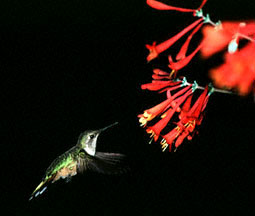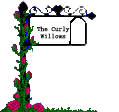 Home
Home  Gardens
for the Hummingbirds
Gardens
for the Hummingbirds
Hummingbird Pictures/ How to identify
Hummingbird Facts & Information
Nature's little jewels. Hummingbirds are the smallest of North American birds, all with long slender bills adapted for reaching deep into tubular flowers. Wing beat is so rapid it produces a humming sound. All species feed while hovering and can also fly backward. Throat feathers look black when light does not reflect the brilliant iridescent colors. Young birds resemble females; some are difficult to identify. All are fearless and pugnacious, Males have a "pendulum" courting flight with distinctive patterns for some species Migrate by day, flying low. Eggs, 2, are small, white. Few have a song however, most all have a rapid squeaky chipping [or a clicking] sound. |
Hummingbirds can be found in a wide variety of environments in the New World, from the high Andes (over 4000 m.) to lowlands, and from dry desert areas to the rain forests. In all these environments, their source of nutrition is primarily nectar from flowers, as well as sources of protein such as insects and tiny spiders. They also need places to perch and rest during the day and to sleep at night, usually trees or large plants such as cacti. Nearly all must bathe regularly. Understanding these essential facts is the key to attracting them to a yard or other location.
Flowers should be chosen for their ability to produce nectar, to grow well in your particular region, and to be in bloom when the hummingbirds need them. These provide the fundamental basis for creating a hummingbird-friendly yard or garden.
Color can be important to a hummingbird's search process for locating flowers containing nectar. The majority of plant species that are known to attract hummingbirds have blossoms that are red to orange in color. Hummingbirds are not that restrictive, however, and will regularly visit blossoms of any color which they learn contain sufficient nectar to make it worth their time.
There are several possible explanations for the preference of red flowers. Since insects also seek nectar, they can be regarded as competitors. Most insects see well in the visible and near-ultraviolet but poorly in the red end of the spectrum. Said another way, a red blossom may appear nearly black and unattractive to some insects--but not to the hummer, which can see not only the full visible spectrum but also some in the ultraviolet (as indicated by the presence of a 4th cone in the retina). This makes it less likely that an insect has taken nectar from a red flower, i.e., increases the odds of successful foraging for the hummingbird. Hummingbirds are extremely fast learners. Another possible explanation is that during migration, red blossoms contrast more strongly with a green environment than do other colors.
Blossom shape can be a determining factor to flowers that are visited by hummingbirds. Nectar contained in a long, tubular blossom is easily extracted by a hummingbird, whose tongue can extend a distance equal to its beak length and reach where most insects cannot. Downward-hanging blossoms with no "landing" platform are also less attractive to insects. Below is an inflorescence of Lonicera sempervirens (Trumpet Honeysuckle), a hummingbird favorite, and illustrative of a blossom that displays all desireable characteristics.

Nectar volume influences a flower's attractiveness. Very tiny blossoms, such as those on the Butterfly Bush (Buddleia) or Lantana may offer nectar but require many visits to make it worthwhile, and thus may not be the favorites except for small species. Even Columbines (Aguilegia spp.), often listed as a hummingbird favorite, are less attractive to larger hummingbird species than smaller ones. At the other end of the spectrum the common Trumpet Creeper (Campsis radicans) produces one of the highest known volumes of nectar per blossom.
Fragrance: Most hummingbird flowers have no fragrance, adding another reason as to why insects visit them infrequently. Hummingbirds have little or no sense of smell.
Choosing flower species: A thorough answer to this question is beyond the limits of this web page, although it will be addressed in the future in the Gardener's Corner. The following information may be useful.
A visit to a local nursery and/or garden club is usually the best starting point. Find experienced individuals who can tell you which species and varieties grow well in your area and have a history of success in attracting hummingbirds. Long lists of plant species are interesting but usually lack the kind of detailed information to differentiate them for your area. Similarly, lists that work for residents of the U.S.A. are often of little value to the gardener in Santiago, Chile, or San Jose, Costa Rica. We repeat: local advice can be of exceptional value to planning a hummingbird garden.
With the above qualification in mind, here are some plant families to be considered. Often the best choices in each family are the red or orange varieties, and possibly purple. Plants that are native to your area may have the best odds of survival and be readily familiar to hummingbirds, but be imaginative.
The 10 Best Plant Families for Attracting Hummingbirds* |
|
|
Mint Family |
Columbines Aquilegia spp. |
| Honeysuckles Lonicera spp. esp. Trumpet Honeysuckle (L. sempervirens) |
Bignonia Family Trumpet Creeper Cross Vine Desert Willow Yellow Bells |
| Penstemons Penstemon spp. |
Lobelias Lobelia spp. esp. Cardinal Flower (L. cardinalis) L. laxiflora |
| Mallow Family Turk's Cap Flowering Maple (Abutilon pictus) Hollyhock (as Alcea rosea) Hardy Hibiscus Rose of Sharon |
Evening Primrose Family Fireweed (Epilobium angustifolium) California fuchsia (Zauschneria californica) Fuchsias (Fuchsia spp.) |
| Morning Glories Ipomoea spp. esp. Cypress Vine Red Morning Glory Scarlet Creeper Bush Morning Glory |
Acanthus Family Desert Honeysuckle Flame Acanthus Chuparosa (Justicia californica) Mexican Honeysuckle (J. spicigera) Shrimp Plant (J. brandegeana) |
* Courtesy of Sheri Williamson, Southeastern
Arizona Bird Observatory;
author of Attracting and Feeding Hummingbirds (T.F.H. Publications, Neptune
City, NJ, $7.95) and The Peterson Field Guide to Hummingbirds.
Flowers are the natural way to attract hummingbirds to your yard. However, for many people a flower garden is not an option: no space for a garden; no time to tend it; and perhaps no skill or interest in the garden approach. If you are one of these people, then man-made feeders filled with a mixture of water and ordinary table sugar (sucrose) are an important alternative. Even for those with gardens, feeders provide a supplement to flowers that increases the likelihood of attracting hummingbirds.
Sugar, whether from a flower or a feeder, is essential for a hummingbird's diet. It provides the quick fuel for flight that it needs during waking hours; it is not "junk food." (Human metabolism is not comparable to hummingbird metabolism!) Hummingbirds rely on insects and tiny spiders to provide protein for their diet, since neither flowers not sugar-water mixtures will provide it.
Tests have shown that hummingbirds prefer sucrose in flower nectar over other sugars such as fructose and glucose, so your feeder, with the proper ratio of ingredients, becomes a good approximation to the flowers hummers like best.
FORMULA: 4 parts water to 1 part sugar. The water should not be distilled. The sugar should be white table sugar, not turbinado sugar, brown sugar, or other forms. Use no artificial colors (red dye does NOT help attract hummingbirds) or other additives. Never use honey or artificial sweeteners, for to do so may kill the birds.
PREPARATION: The ingredients can be mixed using cold water. Experience has shown that mixtures do not go bad as quickly if the water is boiled, and the sugar added to it. Do not continue to boil the mixture, as it will turn to syrup. Unused portions of a mixture can be stored in the refrigerator for up to a week.
FEEDER DESIGN: The most important consideration in choosing a feeder is your ability and personal willingness to keep it clean, because feeders vary widely in their ease of cleaning. Feeders with parts that cannot be easily cleaned should be avoided. Some designs can be disassembled and washed in a dishwasher, a convenience but not a necessity. Most all designs work, but some "vacuum" designs cause a dripping problem which will inevitably attract ants. Perches on the feeder are optional, but should be removable if being used when temperatures are at or below freezing. Feeders also vary widely in their attractiveness, from the beautiful to the ugly; be sure you want to look at the design every day!
FEEDER MAINTENANCE: Any mixture of sugar and water will ferment and host the growth of mold spores. This limits the usefulness of the mixture, and it must be discarded regularly to avoid these problems. In moderate temperatures, such as 60-85 degrees F. (15-30 degrees C.) a mixture should last about 3 days; less at higher temperatures, slightly longer at cooler temperatures. Regardless of the mixture's age, discard it immediately if you see cloudiness or you see mold growing in the feeder. Always clean a feeder thoroughly before refilling; do not "top off" a feeder which is low in mixture. Clean with warm water and detergent, and rinse very thoroughly. Use only as much mixture as is being used between refillings to reduce waste. Every few weeks, rinse the cleaned feeder with dilute (1:10) bleach, then rinse VERY thoroughly.
FEEDER PESTS: Ants, bees, wasps--and even bats--can be a problem.
![]()
![]()
 email
us at: thecurlywillows@yahoo.com
email
us at: thecurlywillows@yahoo.com